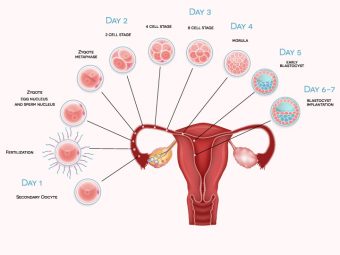
Image: Shutterstock
It is normal for family and friends to guess the gender of the baby when you are pregnant. Some also may suggest that you have symptoms of a baby boy or girl. These assumptions and myths originated over generations out of curiosity, especially when the scans were not available. While guessing or predicting the sex of the baby through symptoms can be fun, they should not be taken seriously due to a lack of scientific evidence. Read on to know some myths associated with the baby’s gender during pregnancy.
What Determines The Sex Of A Baby?
The baby’s sex is determined by its chromosome make-up at the time of fertilization (when the sperm meets the egg). An embryo (or the baby) receives 23 chromosomes from each of the parents, where one pair is made up of the sex chromosomes that determine the sex of the baby. If the baby has two X chromosomes, it is a girl, and if it has one X and one Y chromosomes, it is a boy.
Sexual differences begin around the seventh week of pregnancy, and they are influenced by genetic and environmental factors too (1).
The births in a given population may be naturally male-biased. For example, research shows that the chances of having a boy are slightly higher than a girl’s (23). The below graph depicts the differences in sex ratio at birth for various countries from the year 1950 to 2020. The ratio between the number of male births to every 100 female births gives the sex ratio at birth, and a value greater than 100 indicates the number of boys born is higher than girls born that year. The data suggests that the number of male births has been higher than female births in all countries throughout the years.
Sex ratio at birth from 1950 to 2021
Source: Gender Ratio; Our World in Data/ United Nations - Population Division (2022) Expert says
Expert saysSigns You Are Having A Baby Boy – Myths vs. Facts
Image: Created with Dall.E
Here, we list down some of the common symptoms that people commonly believe are signs of having a boy. Let us explore the myths that can make guessing the sex of the baby fun!
1. Morning sickness
Myth: When you are not experiencing morning sickness or nausea, it is a sign that you are carrying a baby boy.
Fact: Morning sickness (nausea and vomiting) is a common symptom of pregnancy, affecting between 70% and 80% of pregnant women. It is mostly limited to the first trimester, but some women may experience it until delivery (2). Hormonal changes are believed to cause it, and not the sex of the baby.
2. Heart rate
Myth: A heart rate lower than 140 beats per minute is one of the signs you’re having a boy.
Fact: It is a misleading claim with no research to support it. A study titled Gender-Related Differences in Fetal Heart Rate during the First Trimester debunks the myth saying there is no significant difference between heart rates of the boy and girl in the first trimester (3).
Irrespective of the sex, the normal fetal heart rate is 120 to 160 bpm. It may go higher (140 to 160bpm in early pregnancy, and lower (120 to 140bpm) towards the later stages of pregnancy (4).
Dr. Alan Lindemann, obstetrician and maternal mortality expert, who was also a clinical associate professor at the University of North Dakota, Grand Forks, says, “While there are people who say that the baby girl’s heart rate is faster than the boy’s, I would say this is an extremely unreliable way to determine the gender of the baby. The most reliable way to determine gender is by an ultrasoundiXA medical test that uses sound waves to examine internal organs and tissues of the body at about 20 weeks or more.”
3. Skin and hair condition
Image: Shutterstock
Myth: Good skin health with blemish and pimple-free skin are signs you are pregnant with a boy, whereas a baby girl borrows the mother’s beauty, deteriorating her skin. The mother will also have longer and lustrous hair in case she’s carrying a boy.
Fact: There are no studies to support these claims. Changes in skin and hair during pregnancyare due to alterations in hormone levels. Hormonal changes can result in clear skin and lustrous hair, or acne and hair fall, irrespective of the baby’s sex.
4. Food cravings
Myth: If you crave for sour or salty foods, you are more likely to have a boy.
Fact: There is no scientific evidence that supports this claim. Cravings could be due to hormonal changes, nutritional deficiencies, pharmacologically active substances (present in specific foods), cultural and psychosocial factors. However, there isn’t enough more research to support these hypotheses (5).
5. Tummy positioning
Myth: Carrying low is one of the signs you are having a baby boy.
Fact: The way you carry does not indicate the baby’s sex. A research study published in the journal Birth, states that neither this nor the other ways of predicting a baby’s sex were right (6). The postural changesiXChanges in the body alignment that occur due to various factors, including age, diet, bone density, and certain medical conditions of a pregnant woman may be related to the size of the baby and the shape of your uterus (7).
According to Greg Marchand, a board-certified OB-GYN, working as a program director for the SLS-accredited fellowship in minimally invasive gynecologic surgery at Steward Health, Providence, Rhode Island, “There are no appreciable differences between carrying a boy and a girl. Many moms believe that carrying one gender feels different from the other when they have had the experience of carrying both, but there are no quality studies showing that women, regardless of how many babies they have had, are able to predict a baby’s gender based on the symptomatology of a pregnancy.”
6. Mood changes
Image: Shutterstock
Myth: You are not prone to mood swings if you are carrying a boy, but you will be if you are pregnant with a girl.
Fact: Mood swings during pregnancy are due to hormonal changes and not due to the baby’s sex (8).
7. Urine color
Myth: The color of your urine changes during pregnancy, and if it appears dark, it indicates that you are carrying a baby boy.
Fact: Urine changes are common during pregnancy. Dark urine might be a sign of dehydration, which could happen due to nausea and vomiting (9). Urine color may also change with foods, medications, and supplements, and is not related to sex prediction.
8. Breast size
Image: IStock
Myth: When you carry a baby boy, your right breast is bigger than the left one.
Fact: Hormonal changes during pregnancy improve the blood flow and cause changes in the breast tissue that make them feel bigger. Breasts tend to swell as they prepare for breast milk supply to nurture your baby after Breasts tend to swell as the pregnancy proceeds and this swelling helps prepare for breast milk supply to nurture your baby after birth (10). However, there is no evidence of breast changes being linked to the sex of the baby.
9. Cold feet
Myth: If you have icy-cold feet, it is an indication you are carrying a baby boy.
Fact: Cold feet during pregnancy could be due to poor blood circulation, diabetes, or extremely cold weather (11).Consult your doctor for further diagnosis and care.
10. Weight gain
Image: Shutterstock
Myth: When you carry a baby boy, the extra pounds are mostly visible at the stomach, but when you are carrying a girl, the weight is distributed all over the body, including the face.
Fact: Most pregnant women gain weight throughout their pregnancy, and a considerable weight gain is an essential part of a healthy pregnancy and is not determined by the sex of the baby (12).
Medical Tests That May Indicate Your Baby’s Sex During Pregnancy
Some of the standard medical procedures that can be used to determine your unborn baby’s sex:
1. Ultrasound
It is a non-invasive way to determine the sex of the baby and is usually done between weeks 18 and 22 (13). The ultrasonographer may not always detect the sex if the baby’s position is not ideal or if the pregnancy has not progressed. In these cases, you may have to go for a repeat scan.
 Did you know?
Did you know?2. Fetal DNA blood tests
New research by Diana W. Bianchi and her colleagues, published in The Proceedings of the National Academy of Sciences (PNAS) journal, reveals that taking a blood test around weeks 6 to 10 may help detect the baby’s sex.
Dr. Marchand says, “NIPT (non-invasive prenatal testing) is now the most common way for a mother to find out the gender of her baby in the US. These are blood tests using advanced technology to analyze small portions of the fetal DNA found in the mother’s bloodstream.”
The mother’s blood carries traces of fetal DNA, which determines the Y-chromosomal sequence that could reveal the sex of the baby (15). These tests are usually not taken up unless you are over 35 years and need genetic investigation (16).
3. Genetic Testing
There are invasive tests that allow definitive determination of the sex. They include amniocentesisiXA prenatal test that uses a sample of amniotic fluid to diagnose a fetus's genetic disorder or other health concerns and chorionic villi samplingiXA confirmatory prenatal test done after 11 weeks of pregnancy to screen for any genetic or chromosomal abnormalities in the fetus (CVS), like fetal DNA blood test but might not detect the sex as early as them.
Amniocentesis is performed after the 15th week while CVS after 11th week (17). Both carry a low risk of miscarriage and therefore, could be considered for older couples and those with a history of genetic disorders.
If you want the sex of the baby to be a surprise, but still want to have fun guessing if it is a boy or a girl, we have a few ideas listed for you next.
Party Games To Identify You Are Carrying A Baby Boy
Here are some fun games that you can consider guessing the baby’s sex. Note that these practices are only for fun and are not scientifically backed or recommended methods to find out the baby’s sex.
1. The Wedding Ring Trick
- Tie your wedding ring with a long piece of string and then dangle the suspended ring over your bumped belly.
- If the ring swings in a circular motion, it could mean that you’re having a boy.
2. The Key To The Mystery
- In the following trick, you are told to pick up the key placed in front of you.
- According to traditional belief, if you grab the long end of the key, you are having a baby boy. However, if you pick the round end, you are having a baby girl.
3. Chinese Lunar Calendar
- The Chinese birth calendar invented more than 700 years ago is believed to help in the determination of your baby’s sex.
- The chart could determine your baby’s sex by using your exact birth date and month of your conception.
 Quick fact
Quick factFrequently Asked Questions
1. Can the shape of a woman’s bump predict the baby’s gender?
Pregnancy results in many postural changes, due to which the shape, size, and positioning of the belly may change. However, these changes occur because of a stretch in the abdominal wall to accommodate the growing baby and not due to the baby’s gender (8) (20).
2. Is it true that having a lot of heartburn during pregnancy means you’re having a boy?
Heartburn in pregnancy is caused by indigestion and slowed passage of food into the intestines as the growing baby pushes the stomach higher. In addition, there is no evidence suggesting a link between the baby’s gender and heartburn (8).
3. Do pregnant women carrying a baby boy experience different symptoms than those carrying a baby girl?
Although women undergo various physiological changes during pregnancy, no evidence links these changes to the difference between boy and girl pregnancy symptoms. Nevertheless, research has linked pregnancy symptoms to hormonal fluctuations and fetal growth (8).
4. Can hormonal changes indicate the gender of a baby?
Pregnant women have variations in maternal serum human chorionic gonadotropin hormone levels depending on the baby’s gender. Studies indicate that around the third week of pregnancy, MSHCG is 18.5% higher in mothers carrying a female fetus. In addition, studies also show that mothers carrying a female fetus have higher levels of regulatory cytokines, while mothers carrying a male fetus have higher levels of proinflammatory cytokines. However, no variation was found in the hormones estradiol, estrone, and progesterone among mothers carrying either sex (21) (22).
Determining your baby’s gender may be exciting, but maintaining suspense until the delivery date could be way better. Carrying low, more mood swings, dark urine color, or having cold feet are thought to be tell-tale signs or symptoms of a pregnant belly with a boy. These are fun ways to guess the gender, but no reliable scientific signs indicate that you are having a boy or a girl. Medically acceptable methods such as ultrasound after a particular duration, fetal DNA blood tests, or genetic testing are the only ways to get accurate results. However, prenatal sex determination tests are illegal in some countries, and the doctor will not disclose the gender of your baby.
Infographic: Signs You Are Having A Baby Boy – Myths Vs. Facts
You may have heard your aunts or grandparents talking about how they think you might be carrying a boy based on your symptoms. But can such gender predictions be taken as facts? If you are curious about it, learn to differentiate the myths from the facts through this infographic and understand the science behind the symptoms. Illustration: Momjunction Design Team
Key Pointers
- Morning sickness during pregnancy is a common occurrence and has nothing to do with the sex of the fetus.
- According to studies, there is no significant evidence of any difference between the heart rate of male and female fetuses.
- Mood swings are common during pregnancy, regardless of the gender of the fetus.
- The only ways to indicate the baby’s gender is through ultrasound, DNA tests, or genetic tests.
Pregnant and wondering if you’re having a baby boy or a girl? Learn in this video the most common signs and symptoms of having a baby boy during pregnancy.
Disclaimer: Sex-prediction methods are only for fun and do not replace medical examinations. MomJunction believes in gender equality; we do not support or encourage sex determination nor entertain any queries on finding the sex of the baby.
References
- Michael Cummings; Sex Determination in Humans; Chapter 7 Human Heredity; Brandeis University (2006)
http://www.bio.brandeis.edu/classes/heredity/Lecture%20Powerpoints/chapter7-2.pdf - Noel M. Lee and Sumona Saha; Nausea and Vomiting of Pregnancy; Gastroenterol Clin North Am (2013)
https://www.ncbi.nlm.nih.gov/pmc/articles/PMC3676933/ - McKenna D.S et al.; Fetal Diagnosis and Therapy; Karger Journals (2006)
https://www.karger.com/Article/Abstract/89065 - Fetal Heart Beat; OB-GYN 101: Introductory Obstetrics & Gynecology; Medical Education Division Brookside Associates Ltd.
https://oacapps.med.jhmi.edu/OBGYN-101/Text/Pregnancy/fetal_heart_beat.htm - Natalia C. Orloff Julia M. Hormes; Pickles and ice cream! Food cravings in pregnancy; Frontiers in Psychology
https://www.ncbi.nlm.nih.gov/pmc/articles/PMC4172095/ - Perry DF et al.; Are women carrying “basketballs” really having boys? Testing pregnancy folklore; Birth (1999)
https://www.ncbi.nlm.nih.gov/pubmed/10655817 - Antenatal Care Module: 7. Physiological Changes During Pregnancy; The Open University
https://www.open.edu/openlearncreate/mod/oucontent/view.php?id=37&printable=1 - Signs and Symptoms of Pregnancy; The University of California Santa Barbara (2017)
https://sexinfoonline.com/article/signs-and-symptoms-pregnancy - Hyperemesis Gravidarum; University of Rochester Medical Center
https://www.urmc.rochester.edu/encyclopedia/content.aspx?contenttypeid=90&contentid=P02457 - Normal Breast Development and Changes; University of Rochester Medical Center
https://www.urmc.rochester.edu/encyclopedia/content.aspx?contenttypeid=85&contentid=P00151 - Toe Foot and Ankle Problems Noninjury; University of Michigan (2018)
https://www.uofmhealth.org/health-library/footp - Implementing Guidelines on Weight Gain & Pregnancy; The Institute of Medicine and National Research Council of The National Academies
https://www.nas.edu/hmd/~/media/Files/Activity%20Files/Children/Dissemination%20of%20Pregnancy%20Weight/2013-MAR-01/Providers%20Booklet.pdf - 20-Week Ultrasound (Anatomy Scan)
https://my.clevelandclinic.org/health/diagnostics/22644-20-week-ultrasound - Boy or girl? The difficulties of early gender prediction UT Southwestern Medical Center
https://utswmed.org/medblog/gender-prediction/ - Bianchi DW et al.; Isolation of fetal DNA from nucleated erythrocytes in maternal blood; Proc Natl Acad Sci U S A. (1990)
https://www.ncbi.nlm.nih.gov/pubmed/2333281 - First Trimester Screening; Medical College of Wisconsin Department of Obstetrics and Gynecology
https://obgyn.mcw.edu/services/mfm/services/first-trimester-screening/ - Celine Lewis et al.; Non-invasive prenatal diagnosis for fetal sex determination: benefits and disadvantages from the service users’ perspective; Eur J Hum Genet. (2012)
https://www.ncbi.nlm.nih.gov/pmc/articles/PMC3476712/ - Eduardo Villamor et al.; (2010); Accuracy of the Chinese lunar calendar method to predict a baby’s sex: a population-based study
https://pubmed.ncbi.nlm.nih.gov/20618730/ - Which Pregnancy Myths Are Actually True?; University of Utah
https://healthcare.utah.edu/the-scope/shows.php?shows=0_qtd1io6q - Yuval Yaron et al; (2002); Maternal serum HCG is higher in the presence of a female fetus as early as week 3 post-fertilization; NCBI
https://pubmed.ncbi.nlm.nih.gov/11821300/ - Elizabeth Ann L Enninga et al.; (2015); Fetal Sex-Based Differences in Maternal Hormones Angiogenic Factors and Immune Mediators During Pregnancy and the Postpartum Period; NCBI
https://www.ncbi.nlm.nih.gov/pmc/articles/PMC4317383/






















